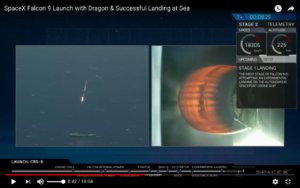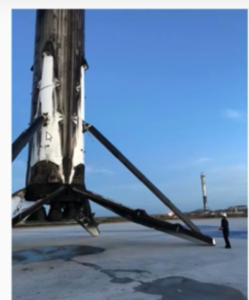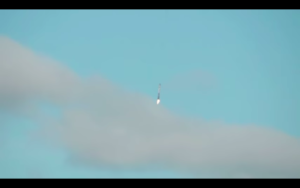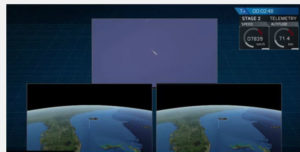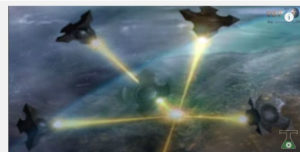My first glimpse of anything ‘Spacex’ was a few months ago and was just a few seconds on the news – one of their ‘boosters’ landing on a barge at sea. I remember laughing and moving on; the image was so preposterous that I didn’t take it seriously, i.e., it didn’t occur to me that it was supposed to be ‘real’ – how little I’ve learned over the years, eh?
My quick look told me a few things: As a lifelong sailor, I could see from the white caps that the seas were of the 4 – 6 foot range, meaning that the platform was pitching, yawing, and rolling enough to make even a helicopter landing iffy, let alone something ‘computer guided,’ and therefore unable to see the over all picture of the target’s motion. (The other thing I assumed was that if the image was in some sense real, it must’ve been a film of a rocket taking off then reversed in playback to give the ‘landing’ effect.)
This stuff registered in an instant; I didn’t really think about it until later: See, the ‘rocket’ is descending backwards, with no airfoil surfaces to guide it at all (the support legs that come out at the last second are not airfoils). Given this, the only ‘force’ causing the projectile to move downward toward the little X on deck is gravity. The rocket engine (in the ‘rear’, but the end closest to the target) fires up just a few seconds (around 15) before landing, to slow the descent. We must assume there’s a computer that controls the tilt of the rocket engine while slowing the projectile down, but with no airfoil surface – like the tail of an airplane – there is no effective means to guide it in flight. (A quick extra burn or two in the upper atmosphere would have little effect on the trajectory.)
In the case of the Falcon Heavy — which ‘failed’ in its landing at sea attempt but let’s assume it had worked (the scare quotes mean it failed on purpose, for ‘realism’) – it disconnected from the upper stage at about 45 miles altitude, near but technically not across the ‘border’ into ‘space.’ The first thing the rocket – call it our ‘tube,’ since a tube is all it is, aerodynamically — has to do is reverse its direction; at the time of separation it’s going nearly 8,000km/hr in the wrong direction. How does it turn around? Let’s assume it has a guidance system that directs the rocket to cop a U turn at this speed – a helluva feat of engineering in itself, but assume it does it.
Addendum: Given that the booster has to, in effect, first stop then reverse direction and speed up to supersonic in the opposite direction, how much fuel do you suppose that would take? (As much fuel as it would take to go from a standing start to like14,000 km/hr?) Just a thought….
Now it has to aim itself at a ship way way waaaay down below and many miles behind it (see the diagram below), taking into account all the physics it must, plus the unknown of the wind velocities once it’s back in the atmosphere. I say velocities plural because there are layers of differing wind speeds and direction. The upper stratospheric winds, for example, can be from the opposite direction as the jet stream (and the former has been clocked at 300 mph), which in turn can be completely different from the surface winds.
Point being that the winds cannot be planned ahead for; they must be adjusted for, during the flight, as the winds change in speed and direction.
Imagine the falling tube encounters unpredicted 100mph winds for 20 seconds. Let’s see… 100 mph equals 146 feet per second… for 20 seconds… that would put the tube over half a mile from the target, with no means of adjustment…
Addendum: I forgot to mention the ‘paddles’ that can be folded out and supposedly used for ‘flight adjustments.’ Have you seen those? They are not airfoils; at most they could adjust attitude.
This, IMO, is just one factor that makes the booster landings (as shown) impossible. There are other reasons but I’ll stick with this one.
Imagine standing at the top of the Empire State Building with a foot long plastic tube and with the wind howling and trying to drop it into a coffee can on Broadway. Sure, you’re gonna say, ‘But it had a rocket engine!’ which is true but, again, it was going backwards. For all intents, all it could do was slow the tube’s fall to earth. The rocket had no means of steering it, to adjust for a 30 plus mile drop through unpredictable winds that can reach 300 mph in velocity.
The idea that it would hit a bulls eye on a heaving deck is too ridiculous to seriously contemplate. What bothers me most is that I have to be the one to say this, apparently. Where are the aeronautical engineers out there? (If you’re reading this, go ahead and try to tell me I’m wrong. And be specific.)
And while I’m at it with the boosters – I’ve mentioned this but tough – I also knew the fix was on when I saw those two boosters land within a second of each other (for dramatic effect, no doubt). Imagine again, the Empire State Building, but now you’re dropping two tubes. What’re the odds they will land simultaneously? Pu-lease. Whaddarya, nuts?
There are multiple reasons I don’t believe what thousands saw and photographed in Florida on February 6th, 2018.
I’ve showed you that the ‘car in space’ video was (poorly) done in a studio. (If you don’t get that by now, what are you doing here?) If you were wondering why they would do that, now you know. They didn’t shoot a rocket into space to begin with, so how else would they show ‘the view’?
If you really need a precedent, try this one: The bastards made two huge buildings disappear (80% of them) on September 11, 2001, nearly two decades ago. They can do what they want.
And remember the words A. Conan Doyle put in the great detective’s mouth: ‘Once you have eliminated the impossible, whatever remains, however improbable, must be the truth.’
Allan
Oh, and if you know a ‘rocket scientist’ and ask him/her about what I’ve said here, be prepared for some hemming and hawing and outright lying (depending on where they work). As soon as you start hearing multi-syllabic horse shit, bring up the wind: ‘But it had to fall backwards through 30 something miles of high and unpredictable winds, with no airfoil to adjust trajectory.’ Something like that.
And if the rocket scientist has any kids, ask how it’s going to go for them if these lies and frauds keep escalating.

